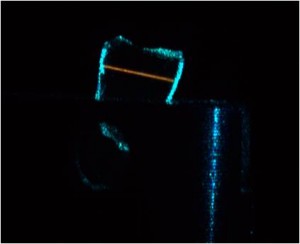The glass–ceramic materials are produced by a controlled devitrification or crystallization from a precursor glass. This process differs from the spontaneous crystallization that is a common problem in the glass production. After the devitrification process, the glass–ceramic material contains an amorphous phase of the remaining glass and one or more nanocrystalline phases, all resulting in a mixture of properties. Transparent glass–ceramics containing rare-earth ions or nonlinear optical crystals have received considerable attention, because such materials have high potential applications in photonics. From the viewpoint of practical applications in integrated optics or photonic crystals, it is important to fabricate transparent glass–ceramics with controlled patterns as micro-scale dots or lines, which can be used as laser waveguides, gratings or wavelength conversion devices.

Orange fluorescence on Dysprosium doped BTS glass when argon laser is passing
Some selected papers about glass and glass ceramics are:
Nanocrystal formation using laser irradiation on Nd3+ doped barium titanium silicate glasses.
Transfer and back transfer processes in Yb3+–Er3+ codoped Strontium Barium Niobate glass-ceramics.
Optical properties of transparent Dy3+ doped Ba2TiSi2O8 glass ceramic.
Structural changes induced on strontium barium niobate glass by femtosecond laser irradiation.
Formation of Nd(3+) doped Strontium Barium Niobate nanocrystals by two different methods.Crystallization effect on Tm3+-Yb3+ codoped SBN glass ceramics.
